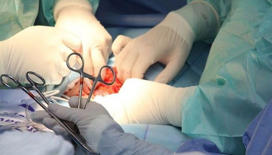UN raises awareness on human organ trafficking

MANILA, Philippines — Human trafficking for organ removal has drawn little attention globally, with only a few cases investigated or prosecuted, according to the United Nations Office on Drugs and Crime (UNODC).
Despite being listed as one of the forms of exploitation in the UN Protocol to Prevent, Suppress and Punish Trafficking in Persons, Especially Women and Children, UNODC said “to date, human trafficking for organ removal has received scant attention from anti-trafficking stakeholders and the international community.”
“All forms of human trafficking tend to be hidden, but human trafficking for organ removal is especially so,” UNODC said.
It is estimated that only 10 percent of global needs for ethical transplants are covered.
“Criminal networks profit from the desperation of patients and coerce vulnerable people into selling organs,” UNODC said.
UNODC has launched a new Toolkit on the Investigation and Prosecution of Trafficking in Persons for Organ Removal, designed to encourage a proactive investigation of possible cases or red flag indicators.
The toolkit focuses on organized criminal networks and on illicit financial flows stemming from them.
UNODC is also inviting UN member-states, international partners and civil society to raise awareness of the issue and to take concerted and informed action.
“The demand for transplants is outpacing supply. Weak donation and transplantation services in many countries have led to ‘transplant tourism' and human trafficking for organ removal. The police and judicial agencies must work with health authorities to prevent and prosecute trafficking in persons for organ removal,” Tedros Ghebreyesus, director-general of the World Health Organization, said.
The lack of expertise in identifying and investigating trafficking for organ has resulted in it being persistently underreported.
The few reported cases confirm that trafficking for organ is a crime that spans the globe.
Noting that the new toolkit is the first of its kind, UNODC executive director Ghada Waly said, “It will give criminal investigators and prosecutors the power to understand the methodology for establishing a complex case of human trafficking for organ removal. Our ultimate aim is to identify potential victims before illicit transplants take place.”
Data showed criminal networks profit from the desperation of the unemployed, refugees, asylum seekers and migrants to pressure them into selling organs.
UNODC said donor victims are recruited following a pattern similar to other types of human trafficking. It can involve the promise of an exchange of small amounts of money, which some may never actually receive. Many victims suffer post-operative complications and health problems.
“Greater attention must be paid to strengthening the regulatory framework around organ transplantation and the means by which so-called ‘buyers' can engage in ‘transplant tourism' to perform illicit transplants,” UNDOC said. “By identifying which health care sectors may be at a higher risk of exploitation, we can better identify possible victims and prevent the crime.”
This “Eyes on Trafficking” story is reprinted from its original online location.
 ABOUT PBJ LEARNING
ABOUT PBJ LEARNING
PBJ Learning is a leading provider of online human trafficking training, focusing on awareness and prevention education. Their interactive Human Trafficking Essentials online course is used worldwide to educate professionals and individuals how to recognize human trafficking and how to respond to potential victims. Learn on any web browser (even your mobile phone) at any time.
More stories like this can be found in your PBJ Learning Knowledge Vault.
EYES ON TRAFFICKING
This “Eyes on Trafficking” story is reprinted from its original online location.
ABOUT PBJ LEARNING
PBJ Learning is a leading provider of online human trafficking training, focusing on awareness and prevention education. Their interactive Human Trafficking Essentials online course is used worldwide to educate professionals and individuals how to recognize human trafficking and how to respond to potential victims. Learn on any web browser (even your mobile phone) at any time.
More stories like this can be found in your PBJ Learning Knowledge Vault.
